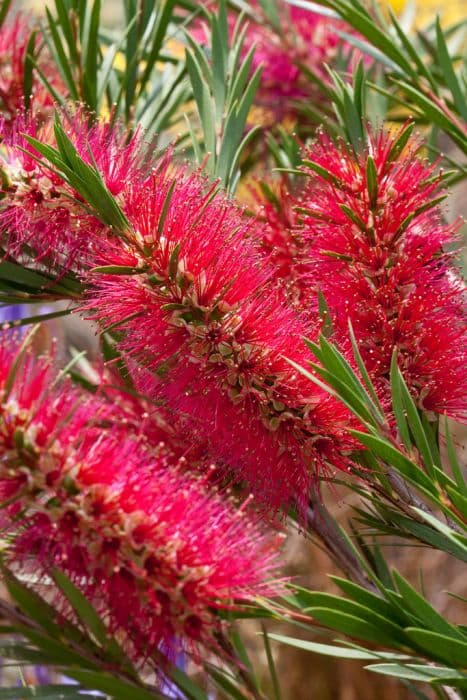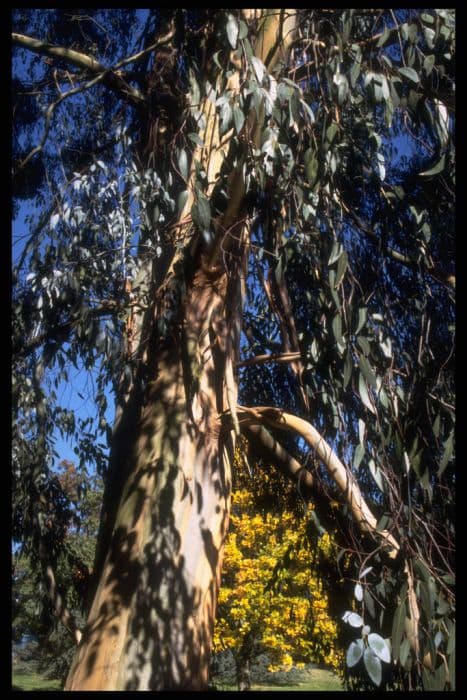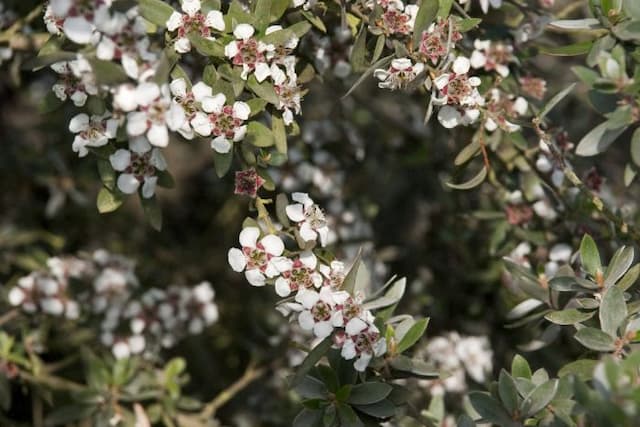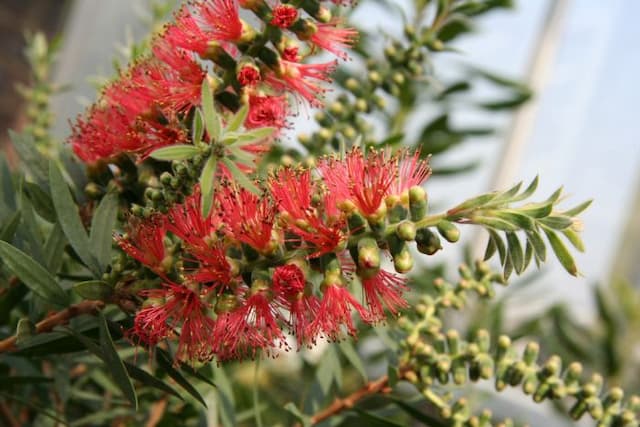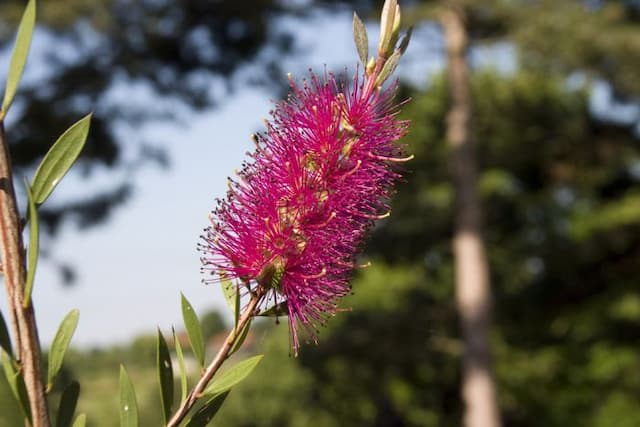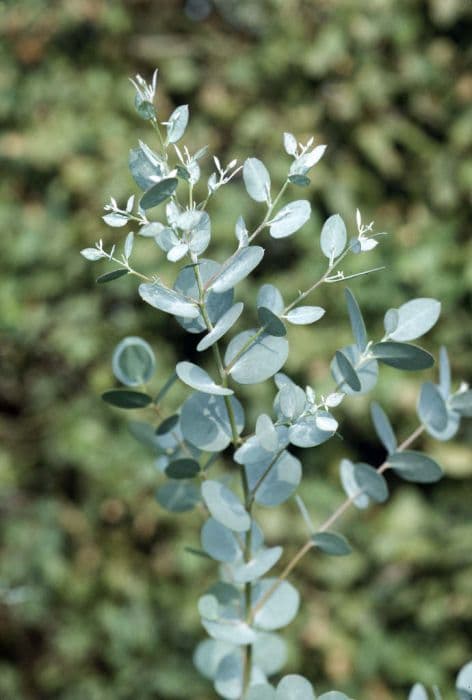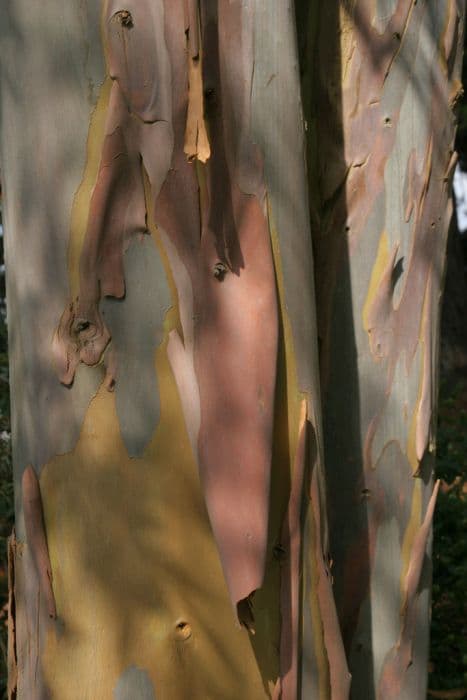Feijoa Acca sellowiana (F)
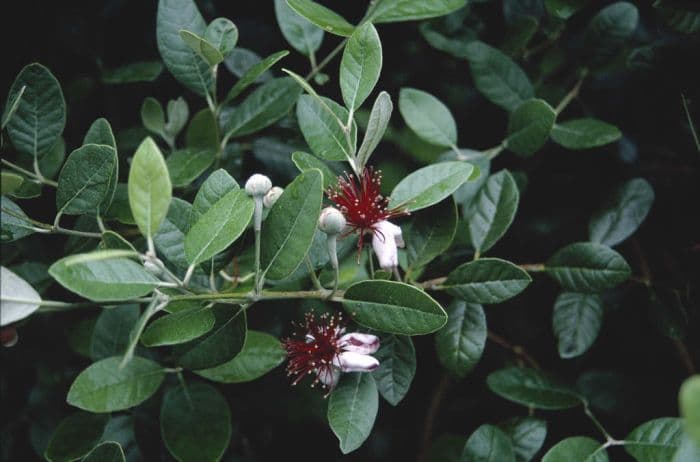
ABOUT
The plant commonly known as feijoa is adorned with a lush, evergreen foliage, which consists of thick, leathery leaves with an elliptical shape. These leaves often have a glossy top surface, which contrasts with a softer, somewhat velvety underside that exhibits a silvery appearance. Throughout its blooming season, the feijoa showcases striking flowers, each composed of a cluster of long, bright red stamens surrounded by white petals with hints of purple on the insides. The fruit that follows is a highlight of this plant. It is oval-shaped, reminiscent of a small green egg, with a skin that has a grainy texture. The interior of the fruit is filled with a cream-colored pulp that's speckled with small seeds. This pulp has a juicy texture and a sweet, aromatic flavor that's often compared to a mix of pineapple and strawberry, with a hint of guava. The feijoa is not just ornamental but also a productive plant, making both a visual and a culinary impact.
About this plant
 Names
NamesFamily
Myrtaceae.
Synonyms
Pineapple Guava, Feijoa, Guavasteen, Brazilian Guava, Fig Guava, Feijoaba.
Common names
Feijoa sellowiana, Orthostemon sellowianus, Acca sellowiana var. rugosa, Feijoa sellowiana var. rugosa, Feijoa sellowiana f. grandiflora, Orthostemon macrophyllus.
 Toxicity
ToxicityTo humans
Feijoa is not commonly known to be toxic to humans. The fruits are edible, and the plant is often grown for its sweet, aromatic fruit. However, as with any plant material, individual allergies or sensitivities could potentially cause reactions, but these are not typical.
To pets
Feijoa is also not known to be toxic to pets. The fruit and plant material are not commonly associated with poisoning in animals. However, always monitor pets when they are around plants, as individual animals might have different reactions, and ingestion of large amounts may cause gastrointestinal upset merely due to the consumption of non-typical food.
 Characteristics
CharacteristicsLife cycle
Perennials
Foliage type
Evergreen
Color of leaves
Green
Flower color
Red
Height
6-10 feet (1.8-3 meters)
Spread
4-8 feet (1.2-2.4 meters)
Plant type
Shrub
Hardiness zones
8
Native area
South America
Benefits
 General Benefits
General Benefits- Edible Fruit: The Acca sellowiana, commonly known as feijoa, produces edible fruit with a unique flavor, which can be consumed fresh or used in various culinary applications.
- Ornamental Value: Feijoa has attractive evergreen foliage and beautiful pink flowers, making it a popular ornamental plant in gardens and landscaping.
- Drought Tolerance: Once established, feijoa plants are relatively drought tolerant, making them suitable for climates with occasional water shortages.
- Wind Resistance: The feijoa is known for its ability to withstand windy conditions, which allows it to be used as a windbreak or hedge in coastal areas and exposed locations.
- Erosion Control: The plant's dense root system can help stabilize soil and prevent erosion on slopes or in areas prone to soil degradation.
- Pollinator Attraction: Feijoa flowers attract bees and birds, such as hummingbirds, thus supporting local ecosystems and pollinator populations.
- Low Maintenance: Feijoa plants require minimal care once established, making them a low-maintenance option for gardeners of all skill levels.
 Medical Properties
Medical Properties- Antioxidant activity: Acca sellowiana, also known as Feijoa, is known to possess significant antioxidant properties, which are crucial for protecting the body from oxidative stress and free radical damage.
- Anti-inflammatory effects: The plant is believed to contain anti-inflammatory compounds, which might be useful in reducing inflammation in various conditions.
- Antimicrobial properties: Some studies suggest that Feijoa may have antimicrobial activities, which might make it beneficial in combatting certain bacterial and fungal infections.
- Gastroprotective effects: There is evidence to suggest that Feijoa may help in protecting the gastrointestinal tract, possibly by reducing the risk of ulcers or soothing gastric discomfort.
 Air-purifying Qualities
Air-purifying QualitiesThis plant is not specifically known for air purifying qualities.
 Other Uses
Other Uses- Feijoa can be used as a natural dye for fabrics, imparting a subtle green hue when its leaves or fruit skins are boiled and used in the dyeing process.
- The crushed leaves of the feijoa plant exude a strong, aromatic scent which can be utilized as a natural insect repellent or to freshen up small spaces.
- Dried feijoa leaves can be steeped to make a flavorful herbal tea that captures the unique fragrance and taste of the plant.
- Feijoa wood, being hard and dense, is well-suited for crafting small wooden items such as handles, knobs, or even jewelry.
- The fruit's pectin-rich content makes feijoa ideal for making homemade jellies and jams that set well without the need for additional pectin.
- Feijoa flowers are edible and can be used as a decorative and flavorful addition to salads or desserts.
- Feijoa skin, often discarded, can be candied or turned into a zest to add a burst of flavor to baked goods or garnishes.
- Feijoa pulp can serve as a natural meat tenderizer due to its enzyme content, akin to the way papaya is used in cooking.
- The plant's leaves contain aromatic compounds that can be used to create perfumes or essential oils with a unique, fruity scent.
- When pruned, the branches and foliage of feijoa can be utilized as fragrant mulch to enrich garden soil and deter pests.
Interesting Facts
 Feng Shui
Feng ShuiThe Feijoa is not used in Feng Shui practice.
 Zodiac Sign Compitability
Zodiac Sign CompitabilityThe Feijoa is not used in astrology practice.
 Plant Symbolism
Plant Symbolism- Resilience: Acca sellowiana, commonly known as feijoa or pineapple guava, is a hardy plant capable of withstanding various climates, and thus reflects the quality of resilience.
- Endurance: Feijoa has the ability to endure less-than-ideal conditions, representing the trait of enduring hardships with perseverance.
- Unique Beauty: With its attractive flowers and distinctive fruits, feijoa symbolizes the idea that beauty comes in many unique and unexpected forms.
- Abundance: The plant is known for producing an abundance of fruit, symbolizing generosity and plenty.
- Nourishment: As a food source through its sweet fruit, feijoa symbolizes sustenance and the provision of essential needs.
 Water
WaterThe common name for Acca sellowiana is the feijoa, also known as pineapple guava. To water this plant, it’s best to keep the soil consistently moist but not waterlogged. During the growing season in spring and summer, water the feijoa approximately once a week with about 1-2 gallons per plant, depending on the size and the weather conditions. In the cooler fall and winter months, reduce watering to every two to three weeks, monitoring the soil to ensure it doesn't dry out completely. It’s important to adjust watering based on rainfall, lessening the amount if natural precipitation is sufficient.
 Light
LightThe feijoa thrives best in full sun to partial shade conditions. A spot that provides at least 6 to 8 hours of direct sunlight is ideal, but the plant can also tolerate dappled light, especially in areas with intense afternoon sun. Avoid deep shade as it can lead to reduced fruiting and a less vigorous plant.
 Temperature
TemperatureFeijoas, or pineapple guavas, grow well in a wide range of temperatures, but they prefer a subtropical climate. They can tolerate temperatures as low as 15 degrees Fahrenheit but can be damaged by harder frosts. The ideal temperature range for a feijoa is between 65 and 85 degrees Fahrenheit. They can survive brief spells of heat above 90 degrees Fahrenheit but may require extra water during these periods.
 Pruning
PruningFeijoas should be pruned to remove dead or damaged wood, to shape the plant, and to open the canopy up to light and air, which helps prevent disease. The best time for pruning is in the late winter or early spring before new growth begins. Moderate pruning can be done annually but limit heavy pruning to every few years to avoid stressing the plant.
 Cleaning
CleaningAs needed
 Soil
SoilThe best soil mix for the Feijoa or Pineapple Guava is well-draining, with a mixture of loam, peat, and sand. The ideal pH level for Feijoa is slightly acidic to neutral, ranging from 5.5 to 7.
 Repotting
RepottingFeijoas or Pineapple Guavas should be repotted every 3-4 years, in late winter or early spring before new growth begins.
 Humidity & Misting
Humidity & MistingPineapple Guava or Feijoa prefers moderate humidity levels but is adaptable to various conditions, making it relatively easy to satisfy.
 Suitable locations
Suitable locationsIndoor
Place Feijoa in bright light and ensure good air circulation.
Outdoor
Feijoa thrives in full sun to part shade with protection from strong winds.
Hardiness zone
8-11 USDA
 Life cycle
Life cycleAcca sellowiana, commonly known as feijoa, begins its life cycle as a seed, which germinates in moist, well-drained soil, generally requiring a warm temperature. Once the seedling emerges, it grows into a bushy shrub with evergreen leaves and matures over several years, during which time it develops a deep root system. The plant reaches maturity and begins to flower, producing distinctive white blossoms with red accents, typically in the spring. Successful pollination, often aided by birds or insects, leads to the development of green, ellipsoid fruits that have a sweet, aromatic taste. The fruits ripen in the autumn and either drop naturally from the plant or are harvested. After the fruiting season, the plant goes into a dormant phase during the colder months, although in milder climates, the feijoa may retain its leaves year-round until the cycle restarts with the next flowering period.
 Propogation
PropogationPropogation time
Spring-Early Summer
Propogation: The most popular method of propagating the Feijoa, also known as Acca sellowiana (F), is through seed sowing. Typically, this is done in the late winter or early spring. To propagate Feijoa by seed, the seeds should first be extracted from ripe fruit and then sown immediately as their viability decreases quickly with drying. They should be placed in a well-draining soil mix, covered lightly with soil, and kept moist until germination, which can take 3 to 12 weeks. Once seedlings have developed a few sets of true leaves, they can be transplanted into individual pots to grow on before being planted out into their final position. Seed propagation can result in variable offspring, which may not be true to the parent plant in terms of fruit flavor and size.


